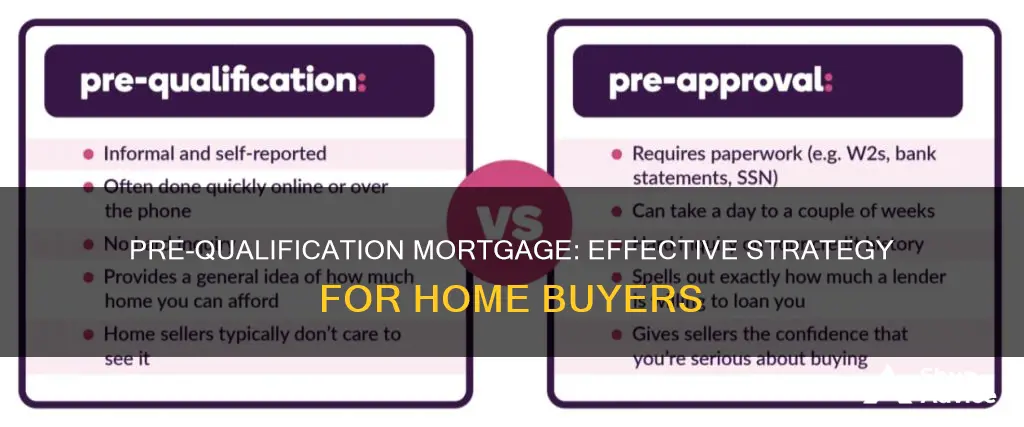
Pre-qualification for a mortgage is a quick process that can be done online, and you may get results within an hour. It is a preliminary step to determine the size of a mortgage you could get, and it is based on a soft credit check and self-reported financial information. It is not a formal mortgage approval but can give you an idea of how much of a mortgage you are likely to be approved for. Pre-approval, on the other hand, is a more involved process that requires submitting documentation for the lender to assess your financial situation and usually involves a hard credit check, which will temporarily lower your score. It gives a more specific estimate of what you could borrow and is taken more seriously by sellers.
| Characteristics | Values |
|---|---|
| Purpose | To give an estimate of how much money a lender might lend for a home purchase |
| Use | To get an idea of what types of homes you can likely afford |
| Requirements | Basic financial information, including income, debt and assets |
| Credit check | Usually only involves a soft credit check, which doesn't impact your score |
| Paperwork | Doesn't require paperwork |
| Weight in the home-buying process | Holds little weight when making an offer on a home |
| Commitment | Not a binding mortgage approval |
| Time taken | Can be done online and may get results within an hour |
| Comparison with pre-approval | Less formal and rigorous than pre-approval |
What You'll Learn
- Pre-qualification is a quick process that can be done online
- It is a preliminary step to determine the size of a mortgage
- It is not a formal mortgage approval but can give an idea of the amount
- Pre-qualification is based on self-reported financial information
- It does not require paperwork or a hard credit check

Pre-qualification is a quick process that can be done online
Pre-qualification is a quick and convenient process that can be done online, over the phone, or in person. It is an early step in the homebuying journey, providing an estimate of what you might be able to borrow based on a soft credit check and a review of your self-reported financial information. This typically includes your income, debt, assets, and monthly debt payments. The entire process can be completed in just a few minutes, and you may even get results within an hour.
While the specifics may vary depending on the lender, pre-qualification generally involves providing basic financial information. This can include details such as your income, expected down payment, and asset information. The lender will use this information to estimate how much you can afford to borrow for a home purchase. It is important to note that pre-qualification is not a guarantee of loan approval, as it is based primarily on the information you provide without extensive verification.
By completing the pre-qualification process, you can gain valuable insights into your homebuying budget and explore different mortgage options. It is a useful way to establish a ballpark figure for your home purchase and avoid looking at houses outside your price range. Pre-qualification also allows you to work with your lender to identify the right mortgage fit for your needs and goals. Additionally, it can help expedite the pre-approval process by giving you an understanding of the information and documentation typically required by lenders.
Although pre-qualification can be done quickly and easily, it holds less weight than pre-approval when making an offer on a home. Pre-approval involves a more thorough review of your finances and requires additional documentation, such as tax returns and proof of income. It provides a more accurate and specific estimate of the loan amount you can secure and is highly valued by sellers as it demonstrates your credibility and financial readiness to purchase a home.
Refinancing Your Mortgage: A Guide to Lowering Payments
You may want to see also

It is a preliminary step to determine the size of a mortgage
When buying a home, it is important to understand the difference between pre-qualification and pre-approval. Pre-qualification is a preliminary step in the mortgage process, giving you an estimate of how much money a lender might lend you for a home purchase. It is based on a soft credit check and a review of your self-reported financial information, including your income, assets, debt and credit score. This process can be completed quickly and conveniently online, in person or over the phone, and it won't negatively impact your credit score.
The pre-qualification amount is not a guarantee of how much you will be approved for, but it is a useful first step to help you establish a budget for your home purchase. It gives you an idea of what types of homes you can afford and can help you avoid looking at houses outside your price range. It also gives you insight into your financial situation and can expedite the pre-approval process by preparing you with the information and documents your lender will need.
Pre-approval, on the other hand, is a more rigorous and involved process that signals to sellers that you are a serious buyer. It involves submitting documentation for a thorough review of your finances, including your income, debt, assets and credit history. This allows the lender to determine how much money you can borrow, how much you could pay per month and what your interest rate will be. While it is not a guarantee that you will get a loan, it does greatly increase your chances of having an offer accepted by a seller.
In summary, pre-qualification is a preliminary step to help you determine the size of a mortgage you could qualify for, while pre-approval is a more in-depth process that provides a more accurate and reliable indication of how much you can borrow.
Prime Mortgage Fluctuations: Understanding the Rise and Fall
You may want to see also

It is not a formal mortgage approval but can give an idea of the amount
While a mortgage pre-qualification is not a formal mortgage approval, it can give you a rough estimate of how much of a mortgage you are likely to be approved for. It is a quick process that can be done online, over the phone, or in person, and you may get results within an hour. It is a preliminary step to determine the size of a mortgage you could get and is based on the data you submit. This can include your income, asset information, and monthly debt payments.
The pre-qualification process is a less involved step, with fewer verification steps completed in most cases. It is a less demanding process than pre-approval, as it relies on self-reported information and doesn't guarantee loan approval. The lender will consider if you'd be likely to meet their qualifications and requirements for a loan, and if so, they'll give you a projection of how much you could borrow.
Pre-qualification is a useful first step in the mortgage process, as it can give you an idea of what types of homes you can likely afford. It can help you establish a ballpark home-buying budget and avoid looking at houses outside your price range. It also gives you insight into whether your credit or finances need to be improved.
However, it's important to note that pre-qualification is not a guarantee, and the lender relies mainly on the information you provide. Therefore, it is less reliable than mortgage pre-approval, which involves a more thorough look at your finances. Pre-approval is more specific and requires documentation such as your W2. It is also more likely to be taken seriously by sellers, as it shows that you are a legitimate buyer with your finances in check.
Money Flows: Understanding Mortgage Money Trails
You may want to see also

Pre-qualification is based on self-reported financial information
Prequalification is an early step in the homebuying journey. It is a quick process that can be completed online, in person, or over the phone in just a few minutes. It is based on self-reported financial information, such as income, debt, and assets, and a soft credit check. Lenders will use this information to provide an estimate of what you might be able to borrow. It is important to note that prequalification is not a guarantee of loan approval, as it is a less formal process than preapproval and does not involve a thorough verification of your financial information.
The self-reported financial information used in prequalification includes basic details such as your income, expected down payment, and asset information. This information helps lenders estimate how much house you can afford and whether you may qualify for a loan of a certain amount. It is important to be as accurate as possible when reporting your financial information, as it will impact the accuracy of the prequalification estimate.
Prequalification can be a useful step for first-time homebuyers who are establishing their homebuying budget and want an idea of how much they might be able to borrow. It can help you determine a ballpark figure for your budget and avoid looking at houses outside your price range. Additionally, it can provide insight into whether your credit or finances need improvement before applying for a loan.
While prequalification is based on self-reported financial information, it may also involve a soft credit check, which does not impact your credit score. This credit check, along with the financial information you provide, will help lenders determine if you are likely to meet their qualifications and requirements for a loan. If you are unsure of your homebuying budget, prequalification can be a valuable tool to help you make an informed decision.
Overall, prequalification is a preliminary step that provides a rough estimate of what you may be able to borrow. It is based on self-reported financial information and a basic understanding of your financial situation. By completing the prequalification process, you can gain valuable insight into your homebuying power and take the first step towards finding your dream home.
SunTrust Mortgage: Navigating Foreclosure and Your Options
You may want to see also

It does not require paperwork or a hard credit check
Prequalification for a mortgage is a quick process that can be done online, and you may get results within an hour. It is a preliminary step to determine the size of a mortgage you could get. It is based on a soft credit check and self-reported financial information such as your income, debt, assets, and monthly debt payments. This means it does not require extensive paperwork or a hard credit check, which can temporarily lower your credit score.
The prequalification process is less involved and less demanding than preapproval, and it is not a binding mortgage approval. It is a good way to get a ballpark estimate of your homebuying budget and to understand how much house you can realistically afford to buy. It is also an opportunity to learn about different mortgage options and work with your lender to identify the right fit for your needs and goals.
Since there is no hard credit check involved, the lender relies mainly on the information you provide, so it is less reliable than mortgage preapproval. The prequalification amount is not a guarantee, and you may qualify to borrow more money than you are comfortable spending on a home. It is important to remember that prequalification is not the same as preapproval, which carries more weight with sellers and involves a more thorough look at your finances.
While prequalification does not require extensive paperwork, some basic financial information and documentation may be required. This can include your income, asset information, and expected down payment. It is a good idea to be prepared with this information and any other relevant documents to expedite the process and get an accurate estimate.
Renewing Your Mortgage Early: Is It Worthwhile?
You may want to see also
Frequently asked questions
Mortgage pre-qualification is a quick estimate of how much money a lender might lend you for a home purchase. It is a less formal process than pre-approval and does not require extensive paperwork or a hard credit check. It is based on self-reported financial information and helps you understand how much house you can afford.
The first step in mortgage pre-qualification is to find a lender that you are comfortable working with. You will then need to provide basic financial information, including your income, debt, assets, and monthly debt payments. The lender will use this information to provide an estimate of the loan amount you could qualify for.
Mortgage pre-qualification can help you establish a budget for your home purchase and avoid looking at houses outside your price range. It also gives you insight into your creditworthiness and can expedite the pre-approval process by helping you gather the necessary documents and information.
Mortgage pre-qualification is a preliminary step to determine the size of a mortgage you could get. It is based on self-reported data and provides a rough estimate of your borrowing power. On the other hand, pre-approval involves a more thorough review of your finances and a hard credit check. Pre-approval provides a more accurate and specific estimate of the loan amount you will be approved for and carries more weight with sellers.







